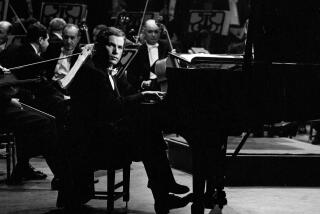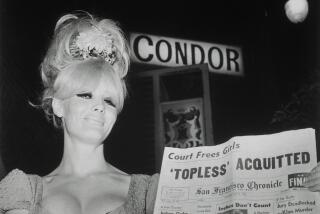‘The San Francisco Tape Music Center: 1960s Counterculture and the Avant-Garde’ edited by David W. Bernstein
The San Francisco
Tape Music Center
1960s Counterculture and the Avant-Garde
Edited by David W. Bernstein
University of California Press/Rensselaer Polytechnic Institute: 336 pp., $65
THERE was a time when the zeitgeist used to get bashed about pretty thoroughly by classical music. New operas, ballets and symphonies would actually alter the cultural climate, chasing away old modes of thought and introducing new realities -- as in 1913, when Igor Stravinsky dropped his “Rite of Spring” on an ill-prepared Parisian public, or in 1952, when David Tudor sat down and closed his keyboard lid for the first live performance of John Cage’s “4’ 33”.” And then there was a moment like the one we encounter in the middle of “The San Francisco Tape Music Center: 1960s Counterculture and the Avant-Garde”: the November 1964 world premiere of Terry Riley’s “In C,” when a new type of avant-garde association challenged the modes of classical music itself.
Riley, along with fellow minimalist Steve Reich, represented the top end of what could be achieved at the San Francisco Tape Music Center, an “autonomous, unaffiliated organization” for composers looking to break into the Digital Age. “I didn’t have to think about it,” Riley says in his interview with the book’s editor, David W. Bernstein, about the genesis of his rhythmic juggernaut. “It was the only thing I’ve ever written that came to me like that. . . . I saw it all on the page, but I didn’t really have a plan of how it would be performed.”
At its premiere, “In C” was performed as though it were a stack of ancient New Orleans jazz cylinders being fed through a futuristic synthesizer blasting wave after wave of rhythm. This was the full flowering of the ethos behind the center as it was envisioned in 1961, when composers Ramon Sender and Morton Subotnick put their radical dreams in motion. The center was to be a place where new approaches to composition were explored, tape loops were built and effects boxes pressed into service in transforming what it meant -- on the West Coast, at least -- to make classical music. Gone were the normal repertory conceits -- string quartet, aria, concerto, movement -- and in their stead came pieces that streamed out through modulators and matrix mixers, with light projections and cinematic backdrops, for a new era of concertgoers. Except that these weren’t concerts so much as happenings: festivals of loops, in which jazzers, rockers, students, poets, filmmakers, acid takers, scholars and cultural philosophers came to be wowed and overcome, or at the least puzzled.
Bernstein’s guided tour of the byways of San Francisco’s digital music scene (a DVD is included) takes the form of a series of conversations, illuminated with a few choice essays. Even if you could care less about classical music and think you’ve read all you need to know about San Francisco’s perpetually progressive culture (especially in the 1960s), there’s still an outlandish episode on nearly every page of this book.
The men and women of the Tape Music Center were not people to be deterred by practicalities or beliefs about how music ought to be composed. The composer and percussionist William Maginnis was responsible for the center’s central work area -- an assortment of output amps, soundboard racks and mixing consoles dubbed the “Great Grand Kludge.” His essay is an audiologist’s delight and features a crystal-meth addict masquerading as an electrical engineer, who stumbles into the center promising to solve all of Maginnis’ mixer problems.
It would take Don Buchla to do that, though, and it is his presence, along with Riley’s, that powers Bernstein’s probing account. One expects to discover little-known -- sometimes painfully unknown -- heroes in books like this, and Buchla is the Tape Music Center’s prime example. Gear heads and electronic composers know of him; there’s a great chance they’d be neither, if Buchla had not invented the equipment that was as vital to the center as any piece of music, given what it made possible. His creation is known as the Buchla box. To avoid having to run around from oscillator to oscillator trying to keep up pitch levels and reconcile the spatial relationships among various sound sources, Buchla found a way to house all these variables in one device. Classical music had entered the DIY age; anyone could compose, in theory, and dynamic wave shaping -- one of the box’s many virtues -- was as easy as twiddling a knob. Even the Hells Angels wanted in.
“They were a little bit associated with [Ken] Kesey’s bus and were involved in drug distribution,” Buchla informs Bernstein. “It all seemed fine to me. I got some interesting tapes from that source.”
A baffled co-interviewer asks Buchla if the Hells Angels were musicians.
“No, you don’t have to be a musician to make a tape,” Buchla responds, revealing one of the center’s key premises. You had to be a musician, or at least capable of thinking musically, to produce art. But this was a new age of musical expression, in which the long-sanctified precepts of classical repertory, with the conservatory and its exclusive trappings and exclusionary tendencies, came tumbling down. “I don’t know the background there,” Buchla concludes his commentary on Kesey’s motley crew. “I just showed up at the places with my instruments, took some acid, played some music.”
There’s a touch of antiestablishment shtick in these lines, but it’s important to note that Buchla is a genuine artist, who understood the relationship between mass participation and digital music years before the mash-up culture made everyone a potential songsmith. At the Tape Music Center, technology transcended its mathematical principles and became something that could inform the beauty that shapes the human soul, with classical music becoming less about the past and more about the future. Or so went the thinking.
Following Buchla’s lead, Sender began to experiment with detached tape heads, making recordings that undermined what was seen as classical music’s obsession with grandeur. “That was when I started doing things like putting all of a Wagner opera on an eighth of an inch of tape,” he tells Bernstein. “I thought, wow I could sell this to conservatory students to help them do their assignments. You want to listen to ‘The Ring of the Nibelungen’? Here, you can do it in a quarter of a second.” As with Marcel Duchamp’s visual constructions and found objects, there’s an element of Dada at work here -- Dada, of course, being not a self-sustaining concept but one that tended to peter out once its point was made.
The Tape Music Center itself didn’t outlast the 1960s, but it did produce a number of pieces that will be around as long as anything concocted by such acknowledged 20th century masters as Alban Berg, Benjamin Britten and Arnold Schoenberg. As Bernstein’s interviews repeatedly make plain, the Tape Music Center, at its best, turned out works that were at once folk art, technological wonder, electro-beat madness and calm, considered statements on the mutability of classical music: a music for all ages and technologies, as suitable to violins and choirs as to Buchla boxes and optical projectors. *
More to Read
Sign up for our L.A. Times Plants newsletter
At the start of each month, get a roundup of upcoming plant-related activities and events in Southern California, along with links to tips and articles you may have missed.
You may occasionally receive promotional content from the Los Angeles Times.






